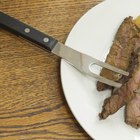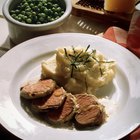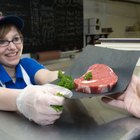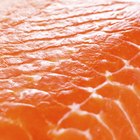ALLEKO/iStock/GettyImages
Kabobs can be made with any type of meat, but consider making them with tri-tip steak. This triangular-shaped sirloin packs just as much flavor as higher priced cuts, but it's affordable and relatively easy to cook. Grilling tri-tip steak the right way takes a little time and finesse, but that extra time you spend pays off in your wallet and in your mouth.
Marinate Your Meat
While a great tri-tip steak has a high amount of marbled fat, the cut's overall fat content is low. This leanness makes it work well for a quick kabob, but it also makes it easy to overcook. Avoid a tough and dry finished product by marinating the meat between 4 and 12 hours. Your favorite marinade will do, but for something a little unusual, try one that uses orange juice or soda as its main ingredient.
Prepare Perfect Pairings
Tri-tip steak pairs nicely with traditional kabob trimmings like onions, peppers and mushrooms, but don’t be afraid to branch out. If you’re looking for a special ingredient, use a hard fruit with high sugar content like pineapple or pear. Stay away from softer fruits, as they tend to get mushy when cooked for more than a few minutes.
Size Matters
No matter the ingredients you choose for your kabob, they should all be cut roughly the same size. If you like kabobs to have a little charring, cut the meat in larger chunks, as anything smaller than 1 1/2 inches makes for overcooked meat.
They’re Fired!
The grill is your only real option for authentic kabobs. Grill over medium heat -- or medium high if you prefer extra charring -- for 3 to 5 minutes on each side, depending on how large you cut your ingredients. Typically, the larger the cut, the longer the cooking time. Stick to rare or medium-rare preparation, as more done preparations make the tri-tip lose its minimal fat content, which makes it chewy and dry. You can tell kabobs are ready to eat when the juices start to run pink and the corners of the meat start to blacken.
Related Articles

How to Cook London Broil

Help Me Cook a Perfect Tender Steak ...

How to Cook BBQ Rattlesnake

For How Long Do You Tenderize Steak ...
How to Cook Steak Florentine Pinwheels

How to Cook a Strip Pepper Steak in the ...

What is a Medallion Cut of Meat?

How to Cook Elk Sirloin

How to Make a Juicy Pork Tenderloin

Does Simmering Ground Beef Make It More ...

How to Grill a Ribeye on a Weber Q

Brisket vs. Tri-Tips

Do You Need to Marinate Flat Iron Steak ...

How to Cook Rump Steak

How to Cook Marinated Pork Loin From a ...

How to Cook Jamaican Jerk Salmon

How to Cook Venison Backstrap Steaks on ...

How to Cook a Tri Tip on a Propane Grill

How to Barbeque a Brisket on a Gas Grill

How Hot Should a Grill Be for Steaks?
References
Writer Bio
Marc Acton has been a professional writer for 10 years. His work has appeared in "GX Magazine," "Foundations Magazine" and on (very) late night television. His TV and film production degree from Ball State University taught him how to tell stories. His experience flying Army helicopters makes him fear no deadline.